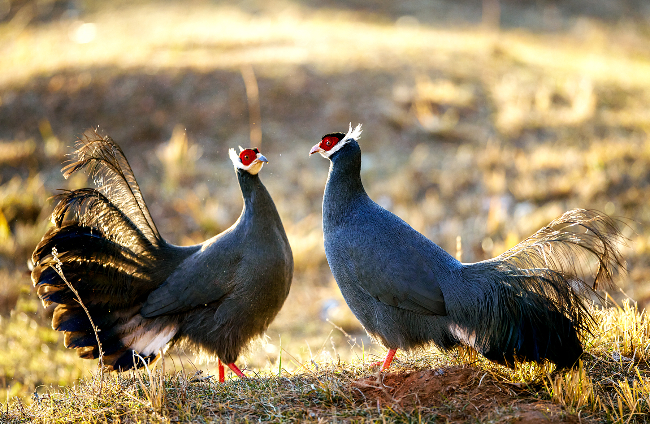The blue-eared pheasant dances in Qilian Mountain National Park

With their vibrant plumage, the blue-eared pheasants forage and frolic in the vast expanse of Qilian Mountain National Park. [Photo provided to gogansu.com]
Recently, staff from the Zhangye Branch of the Gansu Provincial Administration of the Qilian Mountain National Park captured scenes of the national second-class protected wild animal, the blue-eared pheasant, foraging and frolicking in the snow.
The blue-eared pheasant (scientific name: Crossoptilon auritum) is a rare and precious bird species, characterized by crimson sides of the head, white ear tufts protruding from the top of the neck, and an overall bluish-gray coloration. Notably, it possesses exceptionally long and upturned central tail feathers, which, when spread, hang down like a horse's tail, hence its name, the blue-eared pheasant.
During winter, flocks of blue-eared pheasants descend on the foot of the mountains in search of food. Their striking blue plumage stands out against the snowy landscape, making the abundant blue- eared pheasants the epitome of beauty among the wild mountain birds of the Qilian Mountains. While foraging, they often use their claws to scratch and dig in open spaces within the forest, moss, and grassy edges, searching for fallen spruce seeds. This scratching process exposes the soil, facilitating the rooting and germination of spruce seeds, thereby promoting the natural regeneration of spruce forests.
In recent years, the Zhangye Branch of the Gansu Provincial Administration of the Qilian Mountain National Park has continuously intensified efforts in ecological and wildlife conservation, yielding significant results. According to incomplete statistics, the area is now home to a total of 359 species from 80 families across 29 orders of wild vertebrates. Among these, there are 23 species of national first-class protected animals, including the snow leopard, the Thorold's deer, the Tibetan wild ass, and the forest musk deer, as well as 64 species of national second-class protected animals. The forest resources and biodiversity have entered into a positive cycle.
-
As AI encounters Dunhuang's art, the ancient caisson ceiling bridges centuries to the present.
View all stories

 Gansu thrives from green development
Gansu thrives from green development  >
>